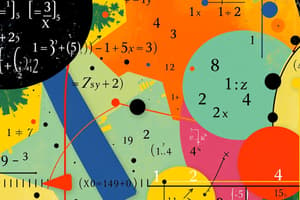Podcast
Questions and Answers
What is Dr. Noura S. Abou Zeinab's role at her institution?
What is Dr. Noura S. Abou Zeinab's role at her institution?
- Assistant Professor in Cell Biology and Histology (correct)
- Research Scientist in Optical Engineering
- Head of Imaging Technology
- Director of Optical Microscopy
Which field does Dr. Noura S. Abou Zeinab specialize in?
Which field does Dr. Noura S. Abou Zeinab specialize in?
- Cell Biology and Histology (correct)
- Pathology
- Bioinformatics
- Optical Microscopy
What type of microscopy is mentioned in the context of Dr. Noura S. Abou Zeinab's work?
What type of microscopy is mentioned in the context of Dr. Noura S. Abou Zeinab's work?
- Electron Microscopy
- Fluorescence Microscopy
- Optical Microscopy (correct)
- Confocal Microscopy
What is a significant focus area related to Dr. Noura S. Abou Zeinab's professional role?
What is a significant focus area related to Dr. Noura S. Abou Zeinab's professional role?
In what academic capacity does Dr. Noura S. Abou Zeinab contribute to her field?
In what academic capacity does Dr. Noura S. Abou Zeinab contribute to her field?
Flashcards
Dr. Noura S. Abou Zeinab
Dr. Noura S. Abou Zeinab
An assistant professor in cell biology and histology.
Image Processing
Image Processing
Methods of improving or altering images.
Optical Microscopy
Optical Microscopy
Microscopy that uses light to view samples.
Cell Biology
Cell Biology
Signup and view all the flashcards
Histology
Histology
Signup and view all the flashcards
Study Notes
Quantitative Imaging: From Cells to Molecules
- BIOL 643 course taught by Dr. Noura S. Abou Zeinab, Assistant Professor in Cell Biology and Histology
- Course focuses on quantitative imaging from cells to molecules
Image Processing
- Quantitative image analysis uses computational algorithms to extract information, features, measurements and patterns from digital images
- Useful for analyzing large image datasets
- Algorithms and manual intervention are used to extract quantitative data
- Example: Developing Arabidopsis flower expressing mCitrine-ATML1 fluorescent protein
- Processed image detects each sepal nucleus and quantifies mCitrine-ATML1 fluorescence
Typical Image Processing Pipeline
- Microscopy: Initial image acquisition using a microscope
- Original image: Raw image captured through microscopy
- Pre-processing: Initial adjustments to the image to prepare it for analysis (e.g. noise removal, contrast enhancement). This stage generally fixes issues in the original image that can produce artifacts when doing analysis.
- Segmentation: Dividing the image into different parts or regions of interest (e.g., separating cells or tissues in the image).
- Post-processing: Further image adjustments for optimal analysis (e.g., color enhancement)
- Data analysis: Extracting meaningful information and quantitative data from the processed image
Step 1: Imaging
- Microscopy: Capturing the original image
- Original image: Raw microscopy image
- Pre-processing: Adjustments to the image
- Segmentation: Separating regions of interest
- Post-processing: Adjustments for data analysis
- Data analysis: Final stage of extracting data
Considerations in Acquiring a Microscopy Image for Computational Processing
- Contrast: High contrast between objects of interest and the background is important
- Color: Images with objects in one color and a black background provide the best results.
- Structure: The structure of interest should be clearly separated
Types of Microscopy
- Optical Microscopy: The most common microscopy type using light.
- Conventional Light Microscopy: Uses visible light to observe samples
- Fluorescence Microscopy: Uses fluorescent dyes to visualize specific molecules
- Confocal Microscopy: Uses a laser to illuminate a thin plane of the sample, eliminating out-of-focus light.
- Phase-Contrast Microscopy: Converts phase shifts in light to brightness changes in the image, useful for transparent samples.
1. Optical Microscopy
- History: Invented by Robert Hooke in 1665
- Types:
- Simple microscopes: Uses a single lens for magnification (e.g., magnifying glass)
- Compound microscopes: Uses multiple lenses to enhance magnification
A - Conventional Light Microscope, Standard Light Microscopy (Bright Field)
- Uses visible light for sample viewing
- Samples often require clearing or sectioning
- Stains enhance visualization and contrast
- Color complexity and shading can make analysis difficult
B - Phase Contrast Microscope
- Light passing through a thin (transparent) specimen produces phase shifts.
- Microscope converts these phase shifts into brightness differences in the image.
- Allows observation of transparent or colorless samples (e.g., living cells) without staining
C - Fluorescence Microscope
- Detects fluorescent dyes attached to specific molecules
- Identifies molecules and their distribution in cells
- Enables observing biological samples in a high degree of detail
D - Confocal Microscope
- Uses a laser to illuminate a thin plane of the sample.
- Eliminates out-of-focus light
- Generates high resolution optical z-stacks.
- Images are generated by pixel-by-pixel laser scanning.
3D Images ("Z-stack")
- 3D image created from a series of 2D images (optical section images) captured at different depths of a sample.
- Collected from a single biological sample.
Pixel and Voxel
- Basic units of an image
- Pixels are 2D
- Voxels are 3D anaog to pixels
- Each has intensity values measured by a detector, ranging from 0 to 255 for 8-bit images
Resolution and Dots per Inch (DPI).
- Resolution is the ability to distinguish features in an image, limited by imaging system properties.
- DPI is the number of dots per inch (pixels per unit distance);
- Journals often require a 300 DPI for images.
- Resampling for decreasing pixels is common, but not increasing resolution.
Limits of resolution surpassed with super-resolution.
- Two sufficiently close fluorophores can’t be resolved using traditional methods.
- Super-resolution techniques overcome this limitation.
Maximum Intensity Projection
- For each pixel, the algorithm selects the brightest z-stack slice.
- This produces an image emphasizing the overall three-dimensional structure of the specimen, particularly its outer surface.
Image Compression
- Methods used to reduce the size of image files
- Lossless methods, e.g., LZW in TIFF, recover the exact original image
- Lossy methods, e.g., JPEG, lose some information during compression
Step 2: Preprocessing
- Includes adjustments to the image following microscopy acquisition to prepare the image for analysis.
Denoising Filters
- Compare target pixels and their surroundings (neighbors) to adjust intensity values, and remove noise
- Types: Mean, Median, and Gaussian blur filters
Studying That Suits You
Use AI to generate personalized quizzes and flashcards to suit your learning preferences.




